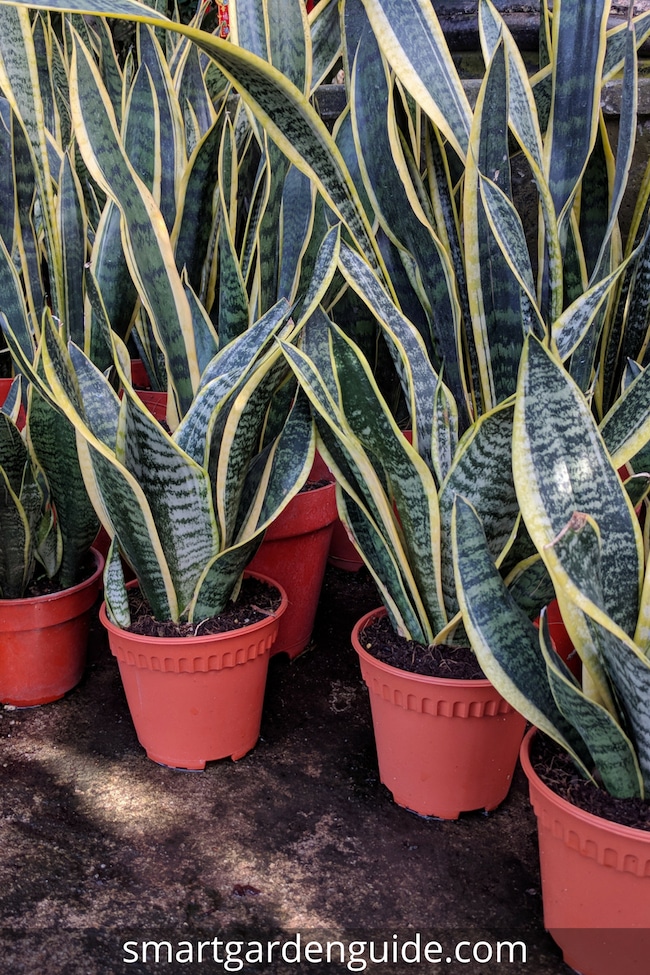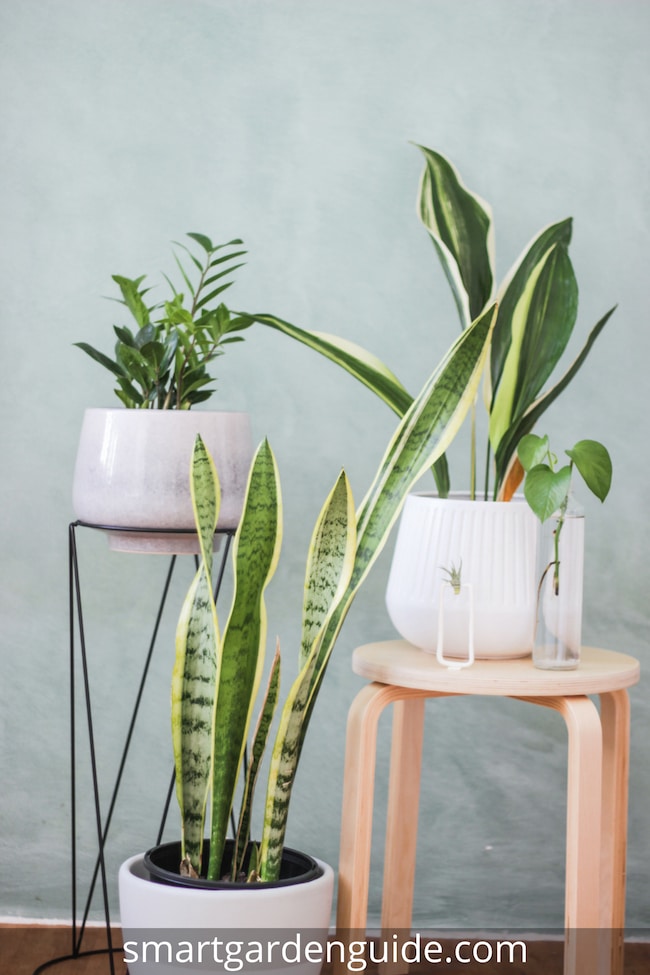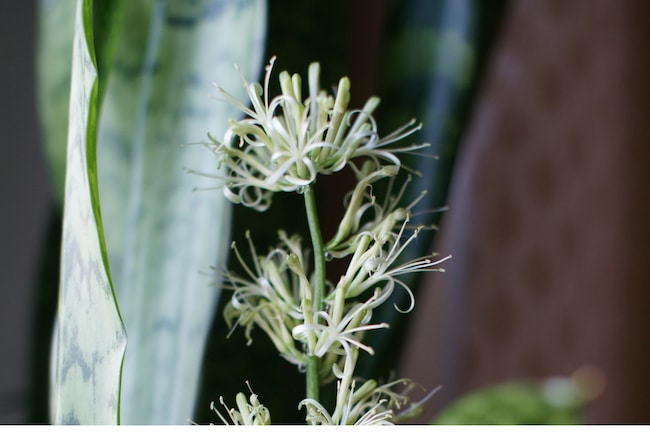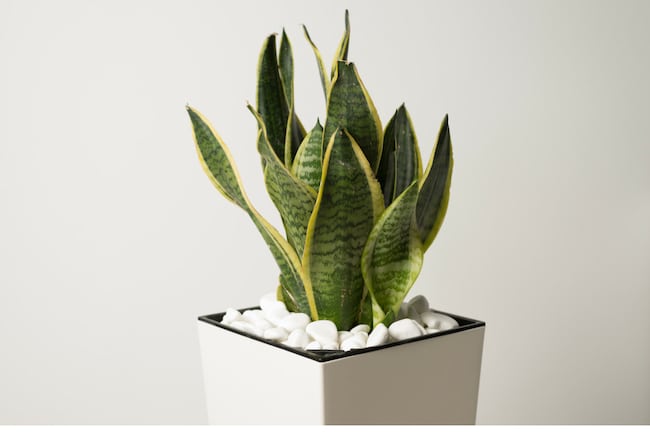The snake plant has been a very popular houseplant since Victorian times, when Londoners were quick to notice that these sturdy succulents brought in from tropical West Africa seemed to be indestructible. Today, snake plants are often said to thrive on neglect. But all it takes is a little time and attention to provide proper snake plant care, and you’ll be greatly rewarded by the bold look of their striking foliage and durable nature.
- Scientific Name: Sansevieria trifasciata
- Common Name: Snake Plant, Mother-In-Law’s Tongue, Bowstring Hemp, Saint George’s Sword
- Origin: West Africa
- Height: Up to 1 to 1.5 meters
- Spread: 0.1 to 0.5 meters
- Soil: Well draining sandy soil
- Light: Bright, indirect light
- Water: Infrequent watering. Drought tolerant.
- Toxicity: Mildly toxic to cats and dogs if ingested.
Introduction to Snake Plants (Sansevieria)
The snake plant belongs to the genus Sansevieria, of which there are over 60 different species. The most common and well known species of snake plant is the Sansevieria trifasciata, although it’s often referred to simply as Sansevieria, since it is the most common and well-known species.
Snake plants are known by several other common names, including mother-in-law’s tongue and Saint George’s sword, because of their long, sharp-edged leaves. Viper’s bowstring hemp is another common name, due to the useful fiber these plants produce.
Mature snake plants can reach up to 5 feet (150 centimeters) high. Snake plants are tall and regal, with tight clusters of long, sword-like leaves that appear to stand straight up in the pot. These robust leaves actually grow vertically up from rhizomes, which are modified stems that grow horizontally while sending out roots from the bottom and shoots from the top.
Snake plants are able to survive in their hot, arid native habitats by storing water in their leaves. Like many other succulents and cacti, sansevieria also have a unique way of conducting photosynthesis that allows them to prevent water loss by only opening their pores at night to take in carbon dioxide and expel oxygen, stowing the carbon dioxide away for use the next day.
Snake plants are incredibly tolerant to neglect. The same characteristics that gives snake plants the tenacity to thrive in severe conditions also makes them low-maintenance, easy-to-care-for potted houseplants that can flourish in a variety of settings.
If you’re having trouble keeping your snake plant healthy, read my guide to why your Snake Plant might be struggling, and how to fix it.

Choosing A Snake Plant
When shopping for a snake plant, look for a healthy plant that appears to be well cared for and shows signs of new growth. A healthy snake plant is dense, sturdy, and vibrant, with smooth, rigid leaves.
Pass up snake plants that have leaves that are yellowing or curling at the tips, as well as plants with droopy leaves, rough spots, or lackluster coloring. And always inspect the leaves of any plant you are considering purchasing for insects.
Don’t be put off by a snake plant that looks crowded in its pot, as their root systems prefer to be quite crowded. Just make sure the pot it’s growing in has a good drainage hole.

Snake Plant Potting Mixture
Because they are accustomed to dry conditions, snake plants need a potting mixture that provides excellent aeration and drainage. The best potting media for snake plants include materials such as perlite, vermiculite, peat moss, loam, coco coir, pumice, and lava rock – and it’s always good to mix in some coarse sand.
Where To Place A Snake Plant In Your Home
While snake plants are famously unfussy and are especially well-known for tolerating low-light conditions, you can show your snake plant a little love by placing it in a location with indirect or filtered sunlight.
To encourage the most vibrant colors and healthy growth, set your sansevieria near a north-facing window (of course, that’s a south-facing window, for those of you reading this from the Southern Hemisphere), or a bright window with sheer curtains, or place it a bit farther away from a source of bright sunlight.
If the lighting is too intense, your snake plant’s leaves will turn crisp and yellow at the edges.And although your plant will survive in a location with low light, too little light will result in inhibited growth, muted colors, and plants that have become thin and weakened as they stretch out in search of light.
Temperature Range For Snake Plants
The temperature range for snake plants is 50-85 F (10-30 C). If you are growing your snake plant indoors, temperature is typically not a concern, although they should be protected from drafts or wafts of cold air.
These plants can be grown outdoors in mild to tropical climates. Just keep in mind that they do best when contained in pots rather than growing in the ground.
Watering A Snake Plant
When it comes to watering your snake plant, less is truly best.
While these plants may not be fussy about much, snake plants will begin rotting quickly when their growing medium is too moist. What happens in this situation is that the roots take up more and more water, in a desperate attempt to gain the oxygen that’s been displaced by water in the growing medium.
This causes the plant’s water storage cells to become overfilled, which causes irreparable damage to the cell structures and eventually leads to rotting of the leaves and roots. For more on plant rot, see the section about snake plant pests and diseases below. I’ve also got another article on the common problems with snake plants, to help you identify why your snake plant is
A good way to determine how often you should water your snake plant is to simply allow the potting mixture to dry out completely before watering again. As with most plants, sansevierias need more frequent watering during the summer, when they are undergoing active growth, so you should water your plant again as soon as it has dried out during this time of year. The frequency will depend on conditions such as the amount of light, temperature, and humidity of the plant’s environment.
During the winter, when it’s resting, your plant should be left dry for longer periods. You’ll know you are under-watering your snake plant if the tips of the leaves start to turn an unhealthy yellow or begin curling in.
To water your snake plant, use a narrow-spouted watering can to deliver water right to the roots and avoid getting the leaves wet, as this will cause them to rot – particularly if water is allowed to remain on them during cool or cloudy weather.
Water thoroughly enough to soak the potting soil, and then allow the pot to drain well. Make sure to empty the saucer after draining, and never leave any standing water in it for more than five minutes or so.
It can be hard to find a really well draining pot that also looks great and fits in with my home decor. For this reason, I always choose the best type of pot for the plant I am growing, but then place it in a slightly larger, decorative pot. This gives me complete freedom to get a really good looking pot, while still providing the best care for my plants. I’ve written an article about some of my favorite decorative pots. Check them out and let me know what you think.
Fertilizing A Snake Plant
Since snake plants are slow growers, this makes them light feeders, so they don’t require much fertilization.
Starting in the spring, feed your snake plant either every 3 weeks using a good, low-nitrogen houseplant fertilizer diluted to half the normal strength or every 4 weeks using regular strength fertilizer made for succulents.
During the winter months, when their metabolism really slows down, you don’t need to feed your snake plant at all.
Snake Plant Pests And Diseases
The main pests to look out for are spider mites and mealybugs, which will both suck sap from the leaves of your snake plant, leaving rough spots or small wounds. As long as you catch the infestation early, you can remove spider mites by wiping them off with a moist cloth, while mealybugs can be dabbed with alcohol. If they’re allowed to proliferate, however, you may not be able to save your plant.
Snake plant diseases are typically the result of rotting caused by too much water. Soft, squishy, or droopy leaves are signs of over-watering. Here again, if you catch the problem early, you can save the plant. Cut off damaged leaves with clean gardening shears as soon as you notice them. And consider repotting the plant in fresh, well-draining potting medium, if the growing medium the plant is in is soggy. Just be sure to cut away any rotting roots if you do this.
Another option is to take cuttings of healthy plant material to propagate new plants. And of course, be sure to allow your snake plant to fully dry out between waterings going forward.
The other water-related problem to look out for is rust spots, which indicate rot caused by water on the leaves.To remove such blemishes, cut the leaf at the bottom and remove it completely.
Snake Plant Leaf Care
To keep your snake plant’s leaves healthy and robust, remove any dust accumulation with a soft, slightly damp cloth. Don’t use commercial products, as they can damage the coating of the leaves.
Rather than cropping a snake plant leaf to remove any damaged areas, you should always remove the whole leaf by cutting it at the bottom, since a cropped leaf won’t grow back from the cut point.
Snake Plant Propagation
Snake plants are easy to propagate, by either leaf cuttings or division.
Leaves can be cut into sections and allowed to form calluses for about 24 hours, then planted in fresh potting medium. Just make sure to keep track of the tops and bottoms because the leaves won’t take if they’re planted upside down.
To propagate by division, simply remove the plant from the potting mixture and cut the rhizomes into sections using sharp shears or a handsaw, making sure that there’s at least one healthy leaf per each section, and then plant the sections. This method is not only faster, but it will also preserve the variegation of the leaves.

Snake Plant FAQ
So, now that we’ve covered all of the important components of proper snake plant care, we’ll walk through some of the most the frequently asked questions about these African beauties.
Is the snake plant poisonous to pets?
The snake plant is considered to be mildly toxic, causing swelling and numbness to the tongue and throat in lower doses, while large doses may result in vomiting, nausea, or diarrhea.
Does a snake plant bloom?
A mature snake plant will sometimes produce small, fragrant, greenish-white or creamy yellow flowers on a long stalk; but usually only when the plant is stressed – often because it has become root bound.

When should I repot my snake plant?
Snake plants rarely need repotting, as their roots prefer to be crowded in their pots. In fact, many snake plant owners will only repot their plant when it is literally bursting out of its pot, that is, when the root system breaks the pot. Repotting may also be necessary if the plant becomes top heavy and begins to fall over. In either of these cases, you should use a new pot that’s no more than a few inches larger than the old one.
The other reason a snake plant might need repotting is if it is suffering from root rot due to over-watering, as previously discussed.
How long does a snake plant live?
While the average lifespan of a snake plant is 5-10 years, they have been known to live as long as 20-25 years. So giving them what they need rather than stressing them out with carelessness or neglect will make all the difference in how long your particular plant will continue to grace your home.
What are some of the most popular sansevieria houseplant varieties?
Sansevieria trifasciata is the most common sansevieria specias, particularly the “Laurentii” cultivar, with its distinctive variegated leaves that have contrasting yellow edges.
“Hahnii” and “Golden Hahnii” are also popular Sansevieria trifasciata cultivars. They are known as bird’s nest sansevierias because of the lovely nestled rosettes formed by their smaller-sized leaves. These plants don’t grow more than a foot (about 30 centimeters) tall.
Additionally, there are several other sansevieria species that are available as houseplants, such as the Sansevieria cylindrica, or cylindrical snake plant. As its name suggests, this plant’s gray-green leaves are round rather than flat in shape. They are striking in the way they jut up out of the growing medium.

